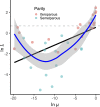Toward a metabolic theory of life history
- PMID: 31822607
- PMCID: PMC6936346
- DOI: 10.1073/pnas.1907702116
Toward a metabolic theory of life history
Abstract
The life histories of animals reflect the allocation of metabolic energy to traits that determine fitness and the pace of living. Here, we extend metabolic theories to address how demography and mass-energy balance constrain allocation of biomass to survival, growth, and reproduction over a life cycle of one generation. We first present data for diverse kinds of animals showing empirical patterns of variation in life-history traits. These patterns are predicted by theory that highlights the effects of 2 fundamental biophysical constraints: demography on number and mortality of offspring; and mass-energy balance on allocation of energy to growth and reproduction. These constraints impose 2 fundamental trade-offs on allocation of assimilated biomass energy to production: between number and size of offspring, and between parental investment and offspring growth. Evolution has generated enormous diversity of body sizes, morphologies, physiologies, ecologies, and life histories across the millions of animal, plant, and microbe species, yet simple rules specified by general equations highlight the underlying unity of life.
Keywords: biodiversity; biophysical constraints; demography; metabolic ecology; unified theories.
Conflict of interest statement
The authors declare no competing interest.
Figures







References
-
- Boltzmann L., “The second law of thermodynamics” in Populare Schriften. Essay No. 3 (Address to Imperial Academy of Science, 1886); reprinted in English in Theoretical Physics and Philosophical Problems (D. Riedel, Dordrecht, Netherlands, 1905).
-
- Lotka A. J., Elements of physical biology. Sci. Progress Twentieth Century (1919-1933) 21, 341–343 (1926).
-
- Smith C. C., Fretwell S. D., The optimal balance between size and number of offspring. Am. Nat. 108, 499–506 (1974).
-
- Charnov E. L., Life History Invariants: Some Explorations of Symmetry in Evolutionary Ecology (Oxford University Press, Oxford, UK, 1993).
LinkOut - more resources
Full Text Sources

